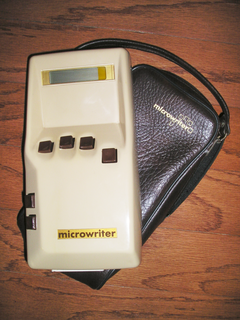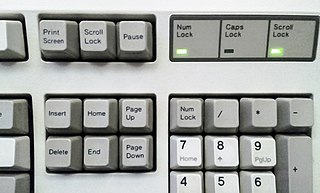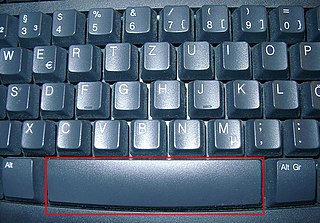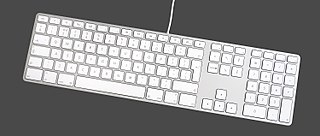Related Research Articles
In computing and telecommunication, a control character or non-printing character (NPC) is a code point in a character set, that does not represent a written symbol. They are used as in-band signaling to cause effects other than the addition of a symbol to the text. All other characters are mainly printing, printable, or graphic characters, except perhaps for the "space" character.

A keyset or chorded keyboard is a computer input device that allows the user to enter characters or commands formed by pressing several keys together, like playing a "chord" on a piano. The large number of combinations available from a small number of keys allows text or commands to be entered with one hand, leaving the other hand free. A secondary advantage is that it can be built into a device that is too small to contain a normal-sized keyboard.

QWERTY is a keyboard layout for Latin-script alphabets. The name comes from the order of the first six keys on the top left letter row of the keyboard. The QWERTY design is based on a layout created for the Sholes and Glidden typewriter and sold to E. Remington and Sons in 1873. It became popular with the success of the Remington No. 2 of 1878, and remains in ubiquitous use.

Scroll Lock is a lock key on most IBM-compatible computer keyboards.
In computing, a modifier key is a special key on a computer keyboard that temporarily modifies the normal action of another key when pressed together. By themselves, modifier keys usually do nothing; that is, pressing any of the ⇧ Shift, Alt, or Ctrl keys alone does not (generally) trigger any action from the computer.

In computing, a Control keyCtrl is a modifier key which, when pressed in conjunction with another key, performs a special operation ; similar to the Shift key, the Control key rarely performs any function when pressed by itself. The Control key is located on or near the bottom left side of most keyboards, with many featuring an additional one at the bottom right.

An electronic keyboard, portable keyboard, or digital keyboard is an electronic musical instrument, an electronic derivative of keyboard instruments. Electronic keyboards include synthesizers, digital pianos, stage pianos, electronic organs and digital audio workstations. In technical terms, an electronic keyboard is a synthesizer with a low-wattage power amplifier and small loudspeakers.

A function key is a key on a computer or terminal keyboard that can be programmed so as to cause an operating system command interpreter or application program to perform certain actions, a form of soft key. On some keyboards/computers, function keys may have default actions, accessible on power-on.

In computing, a keyboard shortcut also known as hotkey is a series of one or several keys to quickly invoke a software program or perform a preprogrammed action. This action may be part of the standard functionality of the operating system or application program, or it may have been written by the user in a scripting language. Some integrated keyboards also include pointing devices; the definition of exactly what counts as a "key" sometimes differs.

Caps Lock⇪ Caps Lock is a button on a computer keyboard that causes all letters of bicameral scripts to be generated in capital letters. It is a toggle key: each press reverses the previous action. Some keyboards also implement a light, to give visual feedback about whether it is on or off. Exactly what Caps Lock does depends on the keyboard hardware, the operating system, the device driver, and the keyboard layout. Usually, the effect is limited to letter keys. Letters of non-bicameral scripts and non-letter characters are generated normally.

The space bar, spacebar, blank, or space keySpace bar is a key on a typewriter or alphanumeric keyboard in the form of a horizontal bar in the lowermost row, significantly wider than all other keys. Its main purpose is to conveniently enter a space, e.g., between words during typing.
The Command key, ⌘, formerly also known as the Apple key or open Apple key, is a modifier key present on Apple keyboards. The Command key's purpose is to allow the user to enter keyboard commands in applications and in the system. An "extended" Macintosh keyboard—the most common type—has two command keys, one on each side of the space bar; some compact keyboards have one only on the left.

Arrow keys or cursor movement keys are buttons on a computer keyboard that are either programmed or designated to move the cursor in a specified direction. The term "cursor movement key" is distinct from "arrow key" in that the former term may refer to any of various keys on a computer keyboard designated for cursor movement, whereas "arrow keys" generally refers to one of four specific keys, typically marked with arrows.

Apple Inc. has designed and released dozens of keyboard models since the introduction of the Apple II in 1977. The current models in use are dual-mode keyboards with integrated batteries: Magic Keyboard, and Magic Keyboard with Numeric Keypad. Both share a similar look and feel, based on a very thin aluminum chassis and laptop-style low-profile keys, sitting much closer to the tabletop than traditional keyboard designs.

Japanese input methods are used to input Japanese characters on a computer.
Control+C is a common computer command. It is generated by pressing the C key while holding down the Ctrl key on most computer keyboards.

A computer keyboard is a peripheral input device modeled after the typewriter keyboard which uses an arrangement of buttons or keys to act as mechanical levers or electronic switches. Replacing early punched cards and paper tape technology, interaction via teleprinter-style keyboards have been the main input method for computers since the 1970s, supplemented by the computer mouse since the 1980s.

In computing, an input device is a piece of equipment used to provide data and control signals to an information processing system, such as a computer or information appliance. Examples of input devices include keyboards, mouse, scanners, cameras, joysticks, and microphones.

A keyboard layout is any specific physical, visual or functional arrangement of the keys, legends, or key-meaning associations (respectively) of a computer keyboard, mobile phone, or other computer-controlled typographic keyboard.
Control-Alt-Delete is a computer keyboard command on IBM PC compatible computers, invoked by pressing the Delete key while holding the Control and Alt keys: Ctrl+Alt+Delete. The function of the key combination differs depending on the context but it generally interrupts or facilitates interrupting a function. For instance, in pre-boot environment or in DOS, Windows 3.0 and earlier versions of Windows or OS/2, the key combination reboots the computer. Starting with Windows 95, the key combination invokes a task manager or security related component that facilitates ending a Windows session or killing a frozen application.